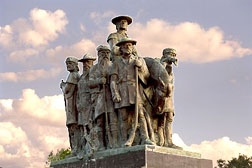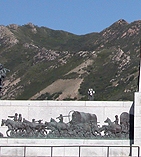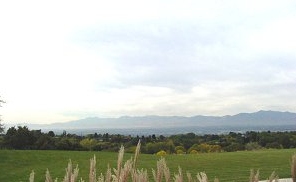|

Trappers and Fur Traders
The trappers and fur traders who flowed into the West in
the 1820's though in quest of furs, were, of necessity, also explorers.
They were the first to report the geography of the Western Empire,
General William Henry Ashley, the figure mounted on the horse was one of
these. Others surrounding him above, are: Jedediah S. Smith, James
Bridger, Thomas Fitzpatrick, Robert Campbell, David E. Jackson, Milton
and William L. Sublette and Hugh Glass. |

The Wagon Trains
The first wagon train of the Pioneer Company to enter
the Valley, July 22, 1847.
An exuberant "Hosanna" exulted from the lips
of Orson Pratt and Erastus Snow as they saw the Valley and entered it
July 21, 1847. They were the first Latter-day Saints to see or set foot
on the future site of Salt Lake City. |
(Lost Photo)
First Europeans
Into the Intermountain Area were the Spanish Explorers
who came in and expedition under the leadership of Father Francisco
Atansio Dominigus, in 1776. In the party were: Bernard Mieray
Pachechok,
Pedro Cisneros, Joaquin Lain and Friar Silvestra elez de Escalante who
kept a daily diary. They were accompanied by five soldiers whose names
appear on the monument placque.
|
|
(Lost Photo)
A party
of nine horsemen were sent into the Valley to search out the best site
for planting potatoes and grain. On the South side of the pylon the five
horsemen are: John Brown, George A. Smith, Jesse Little, an
unidentified man, and John Pack. On the North are: Orson Pratt,
Orin Porter Rockwell, Joseph Mathews, and Erastus Snow.
Six mighty men of
the West are shown individually.
Etiene Provot (1782 - 1850) is noted as the first white man
to explore the valley in the vicinity of surrounding the present site of
Salt Lake City in 1825.
Chief Washakie (1804 - 1900) was Chief of the Eastern
Shoshones. He was a close friend of Brigham Young and the Mormon people.
He was referred to as the "George Washington" of the western
tribesman.
Peter Skene Ogden (1794 - 1854) was the intrepid leader of
Hudson's Bay Fur Company. From 1825 to 1829, he made expeditions into
the West, discovering the Humboldt River in Nevada in 1829. |
Captain Benjamin Louis Elalie de Bonneville (1796
- 1878) traveled extensively in the Northwest and on the borders of the
Great Basin from 1832 to 1835 in search of furs and to conduct a secret
military reconnaissance mission.
Father DeSmet, S.J. (1801 - 1872) as a Jesuit
missionary-explorer became an unofficial goodwill ambassador between Indians
and whites and between tribe and tribe.
John C. Fremont (1830 - 1890) conducted the first
scientific exploration of the Great Salt Lake in 1843. His report and
map, published in 1845, were used extensively by the Mormon Pioneers.
This pathfinder, explorer, statesman and soldier led five significant
expeditions to the West from the year 1842 to 1854. He was the first to
traverse the Great Salt Lake desert directly westward from Great Salt
Lake to the site of modern Elko, Nevada. Other expeditions took him
through the Great Basin clear to California. |
(Lost Photo)
Donner-Reed Party
In 1846 a
party of eighty-seven men, women and children left the Oregon Trail near
Fort Bridger, Wyoming, and sought a 300-mile shortcut to California by
making a new route across the Wasatch Mountains. It was a fatal decision
as hardship after hardship overtook the group. Their trail went down
Echo Canyon, turned south at Henefer, Utah, and after following East
Canyon some fifteen miles, turned westward over Big and Little Mountains.
This delay proved fatal when they were forced to camp at Donner Lake
because of bad weather,
Here, during the winter of 1846-57, thirty-six of their number died from
starvation.

Modern Day View
This is what one sees today from the Monument of The
Great Salt Lake City area.
|


![]()
![]()